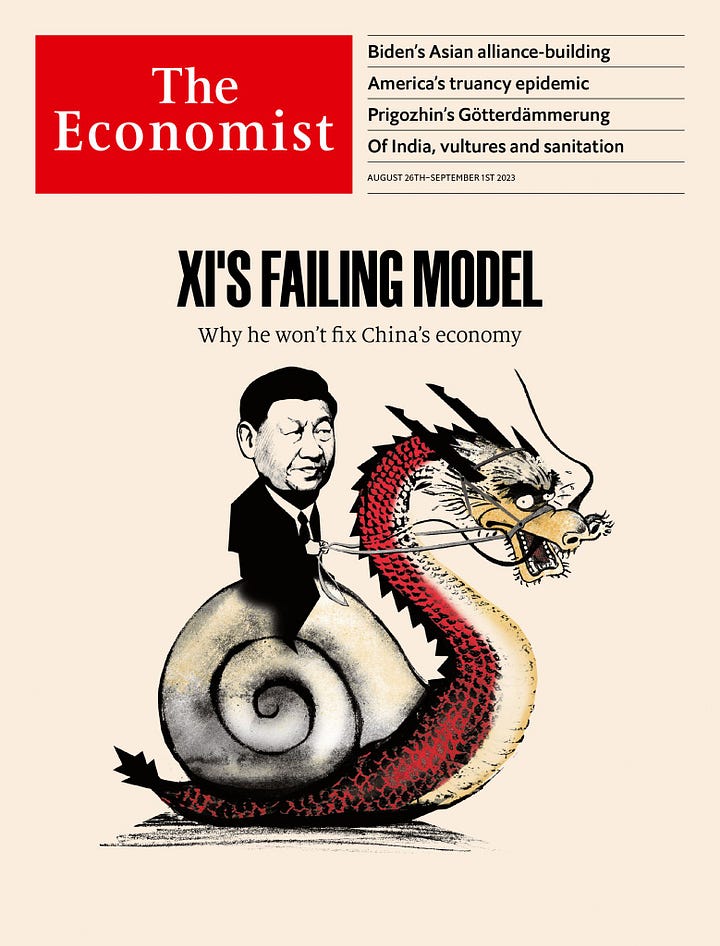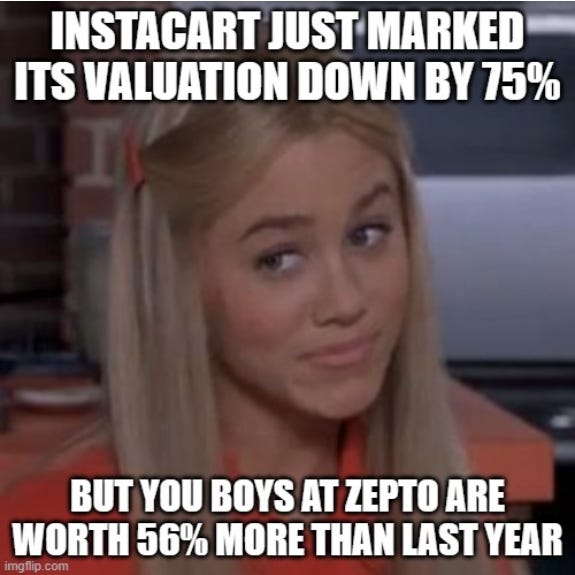A top in the Indian equity moon shot?
The Blind Squirrel's Monday Morning Notes, August 28th, 2023.
Summary
The incredible achievement of India landing a rocket on the South pole of the moon has us contemplating the moon shot that has been Indian equities.
Indian equities are trading on a massive premium to ‘now untouchable’ Chinese assets. The 🐿️ doesn’t buy it.
Acorn thoughts on TLT 0.00%↑ DBA 0.00%↑ WEAT 0.00%↑ $FCOJ GS 0.00%↑ CART 0.00%↑ #uranium AMR 0.00%↑ COIN 0.00%↑
This week’s voiceover covers the front section of the note. You can listen to it by clicking the button at the top of this email. It is also available in podcast format on Apple, Spotify and other podcast apps.
A top in the Indian equity moon shot?
It was Mrs. 🐿️ that called my attention to Chandrayaan-3 (and its little moon rover, Pragyan) this week. My eyes were on Nvidia, Johannesburg and The Teton mountains of Wyoming, and I had failed to notice that India was about to join the elite club of lunar exploration nations. My bad. It’s a phenomenal achievement and the outburst of national pride in India is completely understandable.

I like to think that PM Modi had a bit of fun in South Africa teasing Russian Foreign Minister Lavrov about ‘soft landings’. Modi also has a few bragging rights on the economic front. Based on a recent Reuters survey, India enjoyed annualized nominal GDP growth of 7.7% in Q2. A very different picture from that up in Russia.
India’s dramatic entry into the global space race is made even more impressive by the fact that it was achieved on a budget which at US$75 million (yes that’s with an ‘m’) was the fraction of size of a Hollywood budget for a typical movie about space exploration (or 0.22% of the budget to build Waynesboro, Georgia’s 2 new Vogtle nuclear power plants!).
But what does this achievement deliver to India beyond a short-term adrenalin shot for her nationalist leaders? One really hopes that ‘the forward’ is not one of providing the planet with a low-cost version of Space-X (although it looks like that process may be starting). Too much of India’s recent economic history has been a function of a human capital cost arbitrage with the West.
India’s much vaunted demographic edge has arguably been squandered on optimizing, amplifying or providing a support function to intellectual property emanating from elsewhere in the world. For example, India’s pharmaceutical industry is world class, but largely focused on generics (rather than new compounds).
India’s well-educated, English-speaking army of technical graduates mainly provide middle and back-office support to the West’s financial, telecom and IT giants.


The latest growth narrative for India has revolved around an increasing role for the nation in global manufacturing supply chains (as the West tries to wean itself off its reliance on China). This is going to take time (if it happens at all at scale). The 🐿️ has his doubts.
Russell Clark outlined some interesting thoughts on India in a couple of excellent notes that he published in January ($) and April ($). On top of a ‘Nostradamus’-like premonition of the Adani scandal, he pithily observed that he found it “very hard to believe that US workers having finally managed to get politicians to offer some protection against Chinese competition happily welcome Indian competition.” Great point!
And then you have the problems of ‘doing business’ in India. It’s tough. The 🐿️ has his fair share of war stories involving Indian entrepreneurs! Stories for another time, but Russell puts it very well:
“…a bullish investor could just say to me … just buy India’s biggest and best businesses. Reliance Industries, HDFC Bank, ICICI Bank, Infosys for example. The problem here is that this represents awesome survivor bias. For every Reliance Industries, there is a Reliance Infrastructure (sadly, for investors, controlled by the wrong brother). For every HDFC and ICICI, there is an ILFC, Yes Bank and State Bank of India. And for every Infosys there is a Satyam Computer Services.” [Note that this was written 3 weeks before Hindenberg published its short report on the Adani Group!]
India has created some of the world’s wealthiest billionaires. Often principally thanks to effective government ‘relations’. Success is almost always synonymous with proximity to political leadership (the Adani success ‘story’ and the group’s connection with the Modi administration being a near perfect example).
Then comes the gotcha. But 🐿️, what about India’s amazing demographic destiny? On this, I agree with Clocktower Group’s Marko Papic. In his view, the so-called ‘demographic dividend’ of a young population is only useful if you can employ them gainfully. He saw youth unemployment playing a key role in North Africa’s ‘Arab Spring’, as an example.
India’s problem is that it cannot skip directly to becoming a knowledge and services-based economy (by the way, how does that feel now that Chat GPT is on the scene?). That would mean missing out on the productivity gains that come with a proper industrialization process. Modi probably understands this, but can he, or will he fix it? He has had nearly a decade in office so far with not much progress in terms of legacy-creating infrastructure.
In the meantime, we are being encouraged to get excited about India’s experiment with mimicking the worst of Softbank and Silicon Valley, i.e., selling dollar bills for 50 cents blitz-scaling ‘B2C’ business models. The latest unicorn (will someone please please please retire that word!) being hyped is, Zepto, the country’s Nth ‘quick commerce’ /grocery delivery app and the ‘headline’ US$1.4bn valuation (check the convertible pref term sheet small print on that one lads!) of its latest financing round.
As we also note Instacart’s S-1 filing for its IPO on Friday, these words from Domino’s Pizza CFO Stuart Levy in Feb 2021 ring in the 🐿️’s ears:
“In 60 years, we’ve never made a dollar delivering a pizza. We make money on the product, not on the delivery. So, we’re just not sure how others do it”.
As we discussed last week in From The China Syndrome to Trading Places, the sell side narrative knives are out for Chinese risk assets. And apparently it is Indian equities (“home of the world’s largest democracy and a future global manufacturing supply chain hub”) where global and emerging market portfolio managers want to be.
In fact, discretionary managers have been hiding out in Indian equity overweight positions for quite some time now.
In fact, the EM manager’s only real headache is the fact that India represents 14% of their MSCI emerging markets index benchmark vs China at around 31%. Crowding into this trade would certainly account for a lot of relative outperformance between the 2 markets (as observed below).


The focus appears to be positioning for the next China-style growth story. The private equity ‘bros’ are singing from the same song sheet. A case in point - some toe-curling macro ‘notes from the road’ from the window of an S-Class by a US-based VC. I have comments. Many in fact! Another time. Well, that growth had better come soon because you are sure as hell already paying for it!

This valuation premium has hardly come as a reward for stellar asset price performance in USD terms. And the FX and sovereign bond markets certainly don’t agree. India’s 2-year note has settled back at a 500 basis point premium to that of The Middle Kingdom (where it was 10 years ago) and the CNHINR cross rate has been one way traffic bar the past few months.




I know that I swore myself off adding more China risk last week (there is plenty of direct and indirect exposure there already). I changed my mind. Louis Gave certainly stiffened my resolve with this excellent piece (a rare release from behind the Gavekal firewall).
Brent Donnelly, ‘CIO of Magazine Cover Capital LLC’ has called it, as has everybody’s favorite cloud bear, Paulo Macro. Brent’s weapon of choice is China domestic A-Shares via the ASHR ETF. Paolo intimates that he might be looking at some high beta China tech via the KWEB ETF.
One of the loudest pronouncements in recent weeks has been the death of the Chinese consumer. To those voices, (h/t to my friend Oliver Bolitho at Asia long/short specialists Pacat Capital for the prompt), I suggest that you peruse the latest earnings call transcripts from ANTA Sports and Li Ning. These China consumer names sound a lot more upbeat than what we have been hearing from US consumer and retail names recently. Needless to say, neither company felt the need to devote 20 minutes of their earnings call to the topic of “shrinkage” …
The 🐿️ is tempted to take (a cheeky, given the narrative) swing at China consumption plays via the CHIQ ETF but is concerned that that would not be a fair ‘apples for apples’ comparison with iShares India (INDA), so will stick with FXI, iShares China Large-Cap ETF.
My friend Kevin Muir aka The MacroTourist reminded me last week that pair trading represents ‘twice the risk and half the P&L’ but in the interest of allowing the 🐿️ to break his resolution from last week we will be financing our increased China exposure next week with an offsetting short position in Indian equities.
OK 🐿️, I hear you cry, I get that there is a valuation premium, but where is your catalyst?
I will give you two:
#1: End of the Energy Dividend? Energy prices and the end of the Russia / Ukraine dividend. As you are aware, we think energy prices are about to recommence their climb. India, a major net energy importer, has been enjoying a windfall discount in energy import costs as a result of the West’s Russia sanctions regime. This is becoming increasingly difficult to sustain - The Jamestown Foundation estimates that India’s discount on Russian crude has dropped from US$30 to around US$4 today. The Russia crude dividend since the Ukraine invasion may be about to become an inflationary headwind.



#2: El Niño and the monsoon. The Indian equity markets relationship with the summer monsoon is complex and not without is fair share of Indian equities folklore. However, the effects of El Niño are biting in India. As we have discussed elsewhere, we see continuing evidence that the 2023 Southwest monsoon is failing. Agriculture accounts for 20% of Indian GDP but more significantly over half of the country’s households are tied to the fortunes of the agricultural economy.
We have written in the past about Indian export bans of agricultural products. Onions have now been added to the export ban list that already includes rice, sugar and wheat. Bloomberg’s Joe Wiesenthal will be beside himself with excitement (he is seemingly obsessed with The Onion Futures Act of 1958).
The rainfall deficit in August is expected to be the largest since records began in 1901. The rain shortfall is likely to impact rice, sugar and soybeans yields. Food inflation could be about to rear its ugly head. We suspect that this may be about to weigh on Indian equities.


We will release the implementation strategy in a new Acorn report tomorrow. Update 8/29/23 - now published 👇
Otherwise, that is all we have for the front section this week.
We have a full Acorn review (including a sweet little trade in sugar CANE 0.00%↑ (sorry!)) and portfolio update below, but before you go there…










